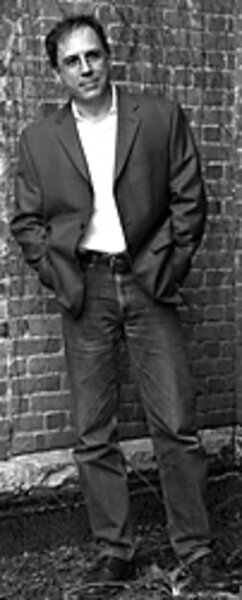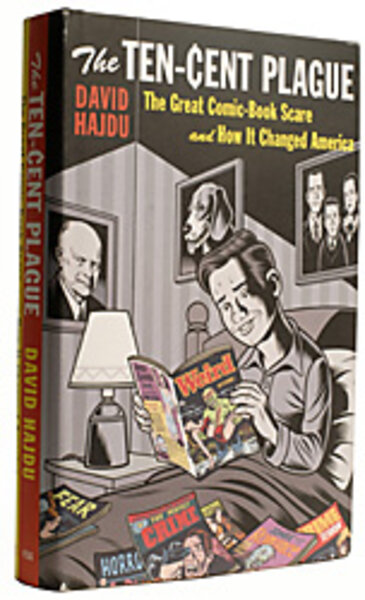Why comic books scared us so
Loading...
In his 1953 novel "Fahrenheit 451," named after the temperature at which paper catches on fire, Ray Bradbury painted a picture of a society beset by book-burning. In his vision, the censors didn't bother to throw comic books on the pyre because they just weren't worth worrying about.
Not so in mid-century America. For more than a decade, countless parents and teenagers made bonfires of comic books, reducing everyone from Captain Marvel to Archie to ashes.
It wasn't so much Superman & Co. that drove the book-burnings, although even the Man of Steel had his critics. Instead, psychiatrists, politicians, and editorial writers feared the most extreme comic books – filled with crooks, monsters, and voluptuous women – would drive innocent children into the clutches of juvenile delinquency.
Amid the outcry, millions of 10-cent comic books vanished from store shelves and 800 people lost their jobs. "[All] they did was tell outrageous stories in cartoon pictures, a fact that makes their struggle and their downfall all the more strange and sad," writes David Hajdu in his revealing new history The Ten-Cent Plague: The Great Comic-Book Scare and How It Changed America.
An estimated 90 percent of all kids ages 8-13 read comics in the 1950s, enjoying tales of heroes and horror along with romance stories geared toward young girls. Critics viewed them all with suspicion, but they were especially disturbed by comics that reveled in blood and guts, sometimes veering into the gory, garish, and blatantly sexual.
Today, comics like "Tales from the Crypt" – which inspired Stephen King and Steven Spielberg – wouldn't raise an eyebrow amid explicit entertainment like "CSI." But back then, many so-called experts found it no coincidence that comic books became popular as horrible stories of youth-gone-wild-filled postwar America.
More to be feared than Hitler?
A psychiatrist named Fredric Wertham stirred the flames in a notorious 1954 bestseller called "Seduction of the Innocent" about the dangers lurking in comic books. "I think Hitler was a beginner compared to the comic-book industry," he inanely warned.
Dr. Wertham, whose background as a civil rights activist has been forgotten, had no patience for super-heroes. He accused Batman and Robin of being light in their leotards, and called Superman a fascist. Wonder Woman, meanwhile, posed a sexually charged threat to morality. (In her early incarnations, Wonder Woman was indeed inappropriate for kids, but Superman was about as fascist as Betty Boop. As for the Caped Crusader and sidekick, one of the men behind Batman joked to Hajdu that their private lives were "their own business.")
As Hajdu notes, Wertham and his cronies often based their much-touted "research" on nothing more than assumptions and a lazy understanding of causes and effects. Yes, some delinquent kids enjoyed comic books. So did almost all other kids. Where was the proof of a link?
But the media believed a rise in juvenile crime was "directly traceable" to the reading habits of kids. In a 1948 editorial The Christian Science Monitor bemoaned the "cheap and lurid sensationalism" of comics. It didn't help matters that many comic books really did revel in crime – unlike censored Hollywood movies, they could let crooks go unpunished – and featured plenty of shapely females.
Once Congress and state legislatures got involved, it didn't take long for the comics world to collapse. Sales dwindled amid tight censorship that required Archie's Betty and Veronica, among others, to stop looking so curvaceous.
Even the creators of Mad Magazine gave in and shuttered their horror titles. (Mad's authority-defying satire survived because it was technically a magazine, not a comic book.)
In an appendix, Hajdu presents a stunning list of hundreds of comic writers and artists – including women and ethnic minorities – who were never heard from again after the 1950s "purge."
One artist, now in her 80s, still bears the scars. "I couldn't go back out there – I was scared to death," she says of her choice to stop illustrating. "Don't you know what they did to us?"
Journalism professor and biographer Hajdu does a fine job of bringing a forgotten chapter of 1950s hysteria back to life, although he could have devoted more space to an examination of what researchers have learned about the effects of exposure to violence.
Today's much tamer comics
Nowadays, of course, comic books and graphic novels often have dark themes but seem positively tame compared with TV and movies. Teachers even use comic books as a tool to encourage reading.
And what of those generations of impressionable kids exposed to dastardly and dangerous comics? Contrary to the dire predictions of the past, most grew up to be as mild-mannered as Clark Kent.
• Randy Dotinga is a freelance writer in San Diego.






